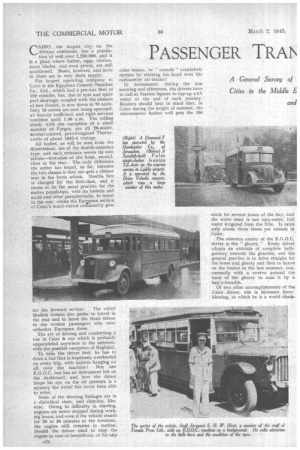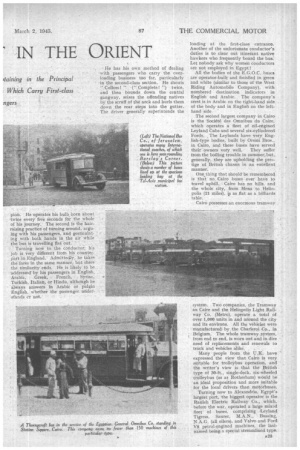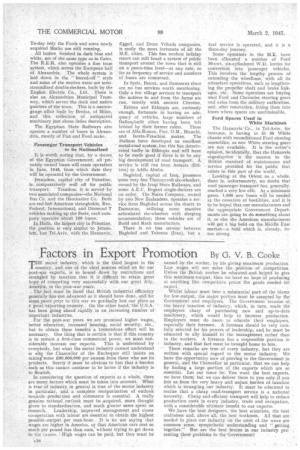PASSENGER TRAIN IN THE ()RIENT
Page 26

Page 27

Page 28

If you've noticed an error in this article please click here to report it so we can fix it.
CAIRO, tic largest cityon the African continent, has a population of well over 1,250,000, and it is a place where butter, eggs, clothes, razor blades, and even petrol, are still unrationed. Buses, however, and seats in them are in very short supply.
The largest operating company in Cairo is the Egyptian General Omnibus Co., Ltd., .which had a pre-war fleet of 150 vehicles, but, due to tyre and spare part shortage, coupled with the absence of new chassis, is now down to 70 units. Only 10 routes are now being operated, all heavily trafficked, and eight services continue until 1.30 a.m. The rolling stock, with the ` exception of a small number of .Fargos, are all 28-seater, normal-control, petrol-engined Thornycrofts of about 1932-4 vintage.
All bodies, as will be seen from the illustrations, are of the double-entrance type, and each entrance serves its own saloon—first-class at the front, secondclass at the rear. The only difference the writer lias found, so far, between the two classes is that one gets a cleaner seat in the front saloon, Double fare is charged for the first-class, and it seems to be the usual practice for the native population, with its baskets and sacks' and other paraphernalia, to travel in the rear, whilst the European section Of Cairo's much-varied community goes for the forward section. The veiled Moslem women also prefer to travel in the rear and to leave the front saloon to the women passengers who wear orthodox European dress.
The art of driving and conducting a bus in Cairo is one which is probably unparalleled anywhere in the universe, with the possible exception of Baghdad. To take the driver first; he has to drive a bus that is hopelessly overloaded on every trip, with natives hanging en all over the machine! Not one E.G.O.C, bus has an instrument left on the dashboard, and how the driver keepshis eye on the oil pressure is a mystery the writer has never been able to solve.
Some a the steering linkages are in a diabolical state, and clutches, like. wise. Owing to difficulty in starting, engines are never stopped during working hours, and even if the vehicle stands for 20 or 30 minutes at the terminus, the engine still remains in motion. Should the driver need to stop -the engine in case of breakdown, or for any.
A24 other reason, he " cancels " ctankshaft motion by sticking his hand over the carburetter air-intake
In midsummer, during the late morning and afternoon, the drivers have to call at Station Square to top-up with water at the end of each journey. Readers should bear in mind that, in Cairo during the height of summer, the thermometer flashes well past the 100
mark for several hours of the day, and the water used is not rain-water, but water irrigated from the Nile. It rains only about three times per annum in Cairo, The common enemy of the E.G.O.C. driver is the "gharry." Every driver adopts an attitude of complete belligerency towards the gharries, and the general practice is to drive straight for the horse and gharry and then to heave on the brakes at the last moment, concurrently with a swerve around the back of the gharry to miss it by a hair's-breadth.
Of two other accomplishments of the Cairo driver, one is incessant hornblowing, at which he is a world cham
pion. He operates his bulb horn about twice every five seconds for the whole of his journey. The second is the hairraising practice of turning around, arguing with his passengers, and gesticulating with both hands in the air while the bus is travelling fiat Out
Turning now to the conductor; his job is very different from his counterpart in England. Admittedly, he takes the fares in the same manner, but there• the similarity. ends. He is likely to be addressedby his passengers in English, Arabic, Greek, French, Syriac, Turkish, Italian, or Hindu, although he always answers in Arabic or pidgin English, whether the passenger under-sfands er not. He has his own method of dealing with passengers who carry the overloading business too far, particularly in the second-class section. He shouts " Colloss ! " •(" Complete! ") twice, and then bounds down the central gangway, seizes the offending natives by the scruff of the neck and hurls them down the rear steps into the gutter. The driver generally superintends the loading at the first-class entrance.
Another of the unfortunate conductor's duties is to clear out itinerant native hawkers who frequently board the bus: Let nobody ask why women conductors are not employed in Egypt!
All the bodies of the E.G.O.C. buses are operator-built and finislied in green and white (similar to those of the West Riding Automobile Company), with numbered destination indicators in English and Arabic. The company's crest is in Arabic on the right-hand side of the body and in English on the lefthand side.
The second largest company in Cairo is the Societe des Omnibus du Caire, which operates a fleet of oil-engined Leyland Cubs and several six-cylindered Fords„ The Leylands have very Eng lish-type bodies, built by Orsini Bros., in Cairo, and these buses have served their " owners very well. They suffer from the boiling trouble in summer, but, generally, they are upholding the prestige of British chassis in an excellent manner.
One thing that should be remembered is that no. Cairo buses ever have to
travel uphill. , Cairo has no hills, and the whole city, from Mena to Heliopolis (21 miles), ij as flat as a billiards table.
Cairo possesses an enormous tramway
system. Two companies, the Tramway an _Cairn and the Heliopolis Light Railway Co. (Metro), operate a total of over 1,000 units in and around the city and its environs. All the vehicles were manufactured by the Charleroi Co., in Belgium. The whole tramway system, from end to end, is worn out and in dire need of replacements and renewals to track and vehkles Many people from the U.K. have expressed the view that Cairo is very suitable for trolleybus operation, and the writer's view is that the British type of 30-ft., single-deck, six-wheeled trolleybus (as at Rotherham) would be an ideal proposition and more suitable for the local drivers than motorbuses.
Turning now to Alexandria. Egypt's largest port, the biggest operator is the Ranleh Electric Railway Co., which, before the war, operated a large mixed fleet of buses, comprising •Leyland Tigress, Saurer, MAN., Bussing, N.A.G. (all oilers), and Valvo and Ford • VS petrol-eng,ined machines, the lastnamed being a sPecial -streamlined type.
To-day only the Fords and some newly acquired iViacks are still running.
All bodies, finished in dark blue and white, are of the same type as in Cairo. The R.E.R. also operates a fine tram system, which serves the European half of Alexandria. The whole system is laid Aown in the " fenced-off" style and some of the motive units are semistreamlined deuble-deckers, built by the English Electric Co:, Ltd. There is also an Alexandrian Municipal Tramway, which serves the dock and natiVe quarters of the town. This is a narrowgauge affair built by Bredas, of Milan, and this collection of . antiquated Machinery just about defies description.
The Egyptian State. Railways also operate a number of buses in Alexandria, mostly of Fiat and Ford make.
Passenger Transport Vebieles , to • be Nationalized it is worth noting that, by a decree, of• the Egyptian Government. all • privately. owned buses will ceaSe Operation in June, 1948, from which date they Will be operated. by the Government.
Jerusalem, capital city of PaleStine, is.. coniparatively well off fen -public transport.Traroless; it is served: by tvvo asseciated companies-the. National Bus Co. and the Hamkasher Co. Both are red-hot'AMerican strongholds, Reo,. Federal, International, and Diamond T vehicles making up the fleets; each company 'operates _about '100 buses.
1ft:1-Jaffa, the largest city in Palestine, the positiOn is very, similar to Jerusatern, hut Tel-Aviv, with. the Hanaavia,
Egged, and Drom Yehuda companies, is easily the most fortunate of all the M.E. cities. This fine modern holiday resort can still boast a system of public transport around the town that is still on a peace-time level—at any rate, so far as frequency of service and numbers of .buses are concerned.
In Syria, Beirut, and Damascus there are no bus services worth mentioning, Only a few village services to transport the natives to and from the farms are run, mostly with ancient Citroens,
Eritrea and Ethiopia are, curiously enough, fortunate in having an adequacy of vehicles, large numbers of Italian-built oilers having been left behind by their former rulers. 'These are of Alfa-Romeo, Fiat, O.M., Bianchi, and Isotta-Fraschini makes. The Italians have developed an excellent metal-road system, but this has deteriorated. badly in Ethiopia and will have to be made good if there is to be any big development of road transport. A service is still run from Asmara (Eritrea) to Addis Ababa.
• Baghdad, capital of Iraq, possesses some very fine Thornycroft six-wheelers, owned hy the Iraqi State Railways, and some A.E.C, Regent single-deckers are on order. The Nairn Company, owned by two New Zealanders, Operates a service from Baghdad across the desert to Damascus, utilizing some massive articulated six-wheelers with sleeping accommodation; these vehicles are of Budd and Mack manufacture.
There is no bus service between Baghdad and Teheran (Iran), but a taxi service is 'operated, and it is a three-day journey.
Some' operators in the M.E. have been allocated a number of Ford 30-cwt. six-cylindered W.D. lorries for conversion into 'passenger vehicles. This involves the lengthy process of extendingthe wheelbase,' with all its attendant operations, such as lengthening the propeller shaft and brake linkages,. etc. Some operators -are buying used Ford and Chevrolet steering gears and axles from the military authorities, and, after renovation, fitting them into buses where spares are unobtainable.
Ford Spares Used in White Machines
The Hanaavia`Co., in Tel-Aviv, for instance, is having to fit 36 White chassis with reconditioned Ford steering assemblies, as new White steering gears are not available. It is thewriter's opinion, incidentally, that the Hanaa,via organization is the nearest to the British standard of maintenance and service provided for the public that exists in this part of the world, Looking at the Orient as a whole, there is, unfortunately, no doubt that road passenger transport has, generally, ,reached a very low ebb. At .a minimum guess, '1-,500 new buses will be needed at the cessation of hostilities, and it is to be hoped that our-manufacturers and the appropriate Government Departments are gibing to do something about it, or else the American manufacturers will get a big hold on the ,Middle East market—a hold' which is, already; far
too strong. •




















































